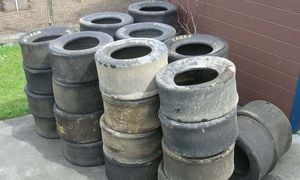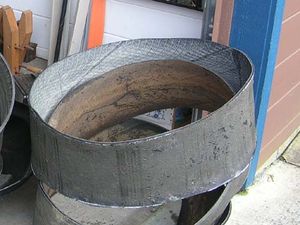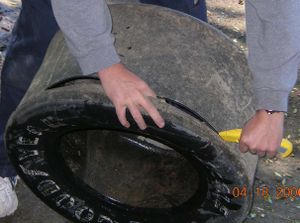No edit summary |
No edit summary |
||
| Line 26: | Line 26: | ||
===Trial and Error=== | ===Trial and Error=== | ||
As with any project there are always mistakes, or learning curves as some might say. So here is where I tell you about what didn’t work (for me). The initial tire concept was based on utilizing radial tires and that changed very quickly. The first tire I tried to cut was, to say the least, very smelly. I tried using a cutting wheel on the end of a drill (spinning at about 30,000RPM) and I found that while it would cut through the bead of the tire and all of the steel belts it wouldn’t cut the rubber, it just melted it. After breathing a cloud of burning rubber and trying it again wearing a breathing mask, I decided that it may not be the most “appropriate” method. That particular method took about an hour and a half with only 8 small shingles being produced. The next method I tried was a jigsaw; it didn’t even cut through the rubber. The tire was too flimsy and would shake, so the jigsaw couldn’t cut it if the tire didn’t stay still. I didnt even get one shingle out of that attempt. The last method I used on the radial tires was a hack saw and let’s just say that it would have taken more than a year to cut the shingles that I needed. | As with any project there are always mistakes, or learning curves as some might say. So here is where I tell you about what didn’t work (for me). The initial tire concept was based on utilizing radial tires and that changed very quickly. The first tire I tried to cut was, to say the least, very smelly. I tried using a cutting wheel on the end of a drill (spinning at about 30,000RPM) and I found that while it would cut through the bead of the tire and all of the steel belts it wouldn’t cut the rubber, it just melted it. After breathing a cloud of burning rubber and trying it again wearing a breathing mask, I decided that it may not be the most “appropriate” method. That particular method took about an hour and a half with only 8 small shingles being produced. The next method I tried was a jigsaw; it didn’t even cut through the rubber. The tire was too flimsy and would shake, so the jigsaw couldn’t cut it if the tire didn’t stay still. I didnt even get one shingle out of that attempt. The last method I used on the radial tires was a hack saw and let’s just say that it would have taken more than a year to cut the shingles that I needed. I then learned that there is only one part of radial tires that don't have steel belts and that is the side wall between the tread and bead. | ||
===The Method Used=== | ===The Method Used=== | ||
After several failed attempts with radial tires, I spoke with a local tire dealer and found that Racing tires only have Steel belts in the side walls, not in the tread. He happened to have an old tire so I took it home to see what I could do. I drilled a hole in the tread and used a key hole saw to start cutting. It went rather smoothly but it did take two people and still took about 45 minutes to make 12 – 14 shingles. Finally I tried a razor blade (just for laughs actually) and found that it cut through the tire like a hot knife through butter. This method cut the time down to minutes. After cutting the side walls off, I had a round thin circle of rubber. Then cut it so it was a long flat sheet (roughly 8” x 80”). | |||
[[Image:Tirering.jpg|thumbnail|center]] | |||
[[Image:Tirestrip.jpg|thumbnail|right]] | |||
[[Image:Razor.jpg|thumbnail|left]] | |||
===Final Construction=== | ===Final Construction=== | ||
Revision as of 19:48, 4 May 2006
Introduction

An introduction goes here.
Information on Tires
Some informaton on chemical makeup and Recycling.
Project Description
General description
Materials for Shingles
- 36 Race Car Tires
- Sharp Razor Blades
Materials for Roof
- (3) 3/4" Plywood sheets
- (2) 8ft 2"x4"
- Screws
- Miscelaneous wood that I had

Clients/Site
Trial and Error
As with any project there are always mistakes, or learning curves as some might say. So here is where I tell you about what didn’t work (for me). The initial tire concept was based on utilizing radial tires and that changed very quickly. The first tire I tried to cut was, to say the least, very smelly. I tried using a cutting wheel on the end of a drill (spinning at about 30,000RPM) and I found that while it would cut through the bead of the tire and all of the steel belts it wouldn’t cut the rubber, it just melted it. After breathing a cloud of burning rubber and trying it again wearing a breathing mask, I decided that it may not be the most “appropriate” method. That particular method took about an hour and a half with only 8 small shingles being produced. The next method I tried was a jigsaw; it didn’t even cut through the rubber. The tire was too flimsy and would shake, so the jigsaw couldn’t cut it if the tire didn’t stay still. I didnt even get one shingle out of that attempt. The last method I used on the radial tires was a hack saw and let’s just say that it would have taken more than a year to cut the shingles that I needed. I then learned that there is only one part of radial tires that don't have steel belts and that is the side wall between the tread and bead.
The Method Used
After several failed attempts with radial tires, I spoke with a local tire dealer and found that Racing tires only have Steel belts in the side walls, not in the tread. He happened to have an old tire so I took it home to see what I could do. I drilled a hole in the tread and used a key hole saw to start cutting. It went rather smoothly but it did take two people and still took about 45 minutes to make 12 – 14 shingles. Finally I tried a razor blade (just for laughs actually) and found that it cut through the tire like a hot knife through butter. This method cut the time down to minutes. After cutting the side walls off, I had a round thin circle of rubber. Then cut it so it was a long flat sheet (roughly 8” x 80”).



Final Construction
Conclusions
Actual Results
Discussion
Hypotheses from results.